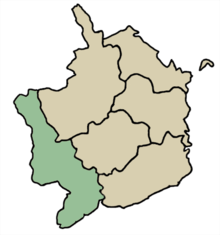Gwynllŵg
Gwynllŵg was a small Welsh kingdom and principality.
It was named after Gwynllyw , a mythical 5th century king. The land stretched in the fertile coastal plain in southeast Wales between the Rhymney and Usk rivers , including the northern barren hill country of the Commotemachen. Gwynllŵg became a cantref of the western kingdom of Morgannwg . The exact course of the Norman conquest in the 11th century has not yet been precisely clarified. In 1081 King Caradog ap Gruffydd of Gwent fell in the battle of Mynydd Carn against King Rhys ap Tewdwr of Deheubarth . Thereafter, the coastal country was presumably conquered by the Norman Baron Robert Fitzhamon , who also drove Iestyn ap Gwrgan from Morgannwg until 1091 . Caradog ap Gruffydd's son Owain Wan could only get a small lordship in the hill country of Mach. This region, now called Gwynllŵg, remained under loose Norman suzerainty. In 1135, Robert of Gloucester , the Lord of Glamorgan, tried to pacify Owain Wan's son Morgan from Owain by handing over some lands to Rumney. However, Morgan ab Owain conquered Caerleon and Usk Castle during the Welsh uprising of 1136 , so that he and his brother Iorwerth also became Lords of Caerleon until the 1170s. It was only Gilbert de Clare, 6th Earl of Hertford and Lord of Glamorgan, who occupied her castle around 1270 and drove out the last Welsh Lord Maredudd ap Gruffudd .
In the lowlands, Robert Fitzhamon probably built Newport Castle towards the end of the 11th century , which became the center of the new Norman rule belonging to the Welsh Marches . The Welsh name Gwynllŵg was Anglicized to Wentloog . Wentloog was nominally a separate rule, but remained in the possession of the Lords of Glamorgan until the 14th century. After the death of Gilbert de Clare, 7th Earl of Hertford , the last male de Clare, Wentloog fell in 1317 to Hugh de Audley , who had married Gilbert's sister Margaret . However, as early as 1318, Hugh le Despenser , who had married Eleanor de Clare , one of the heiresses of the de Clare estates, claimed Wentloog for himself. Only after Despenser was overthrown in 1326 did Wentloog fall back to de Audley. After de Audley's death in 1347, Wentloog fell to Ralph de Stafford , who had married his daughter and heir Margaret in 1336. With the incorporation of Wales into England in 1536, Wentloog became part of Monmouthshire .
literature
- Royal Commission on the Ancient and Historical Monuments of Wales: An Inventory of the Ancient Monuments in Glamorgan , Vol. III - Part I: The early castles. RCAHMW, 1991, ISBN 978-0-11-300035-7 , pp. 20-24
Web links
Individual evidence
- ^ Castles of Wales: Newport Castle. Retrieved April 30, 2014 .
- ^ David Walker: Medieval Wales . Cambridge University Press, Cambridge 1990. ISBN 978-0-521-31153-3 , pp. 56 and 163
